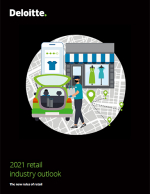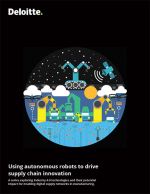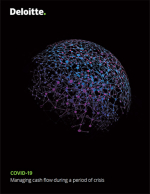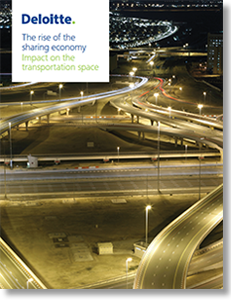The Rise of the Sharing Economy
Impact on the transportation space; In a world of shared assets, changing economics and customer preferences are increasingly driving transportation players not to go it alone.
In only a few short years, the sharing economy has become a ubiquitous concept.
While still in its infancy, the sharing economy has disrupted a number of industries with lightning speed.
Any industry could potentially benefit from, or be disrupted by, the rise of collaborative consumption and the proliferation of asset-sharing models.
However, due to its natural fragmentation and asset intensity, the sharing economy is especially relevant to core transportation companies as well as to heavy users of transportation services.
Changing economics and customer preferences are driving transportation players to not to go it alone
The momentum of the sharing economy is unlikely to dissipate anytime soon.
As a result, core transportation companies and heavy users of transportation services need to learn how to play in a world of shared assets.
The bad news is that mobile technologies and digital platforms are eroding the traditional barrier to entry (i.e., asset ownership) and opening the core transportation industry to a spate of new competitors.
The good news, however, is that these same technologies are also creating new opportunities for forward-thinking incumbents to leverage a shared platform to grow their businesses and enhance their margins.
Core providers connect
Core transportation providers could leverage a network of shared services and assets with a goal of delivering higher value services to companies, while increasing profitability.
These providers could gain greater efficiency and provide better customer service by incorporating a shared platform into their business models. Traditionally, core providers, such as truck leasing companies, either dedicate assets to specific customer accounts or carry planned loads at pre-negotiated rates.
However by utilizing a shared platform, a truck leasing company or other core transportation provider could more effectively market excess capacity across its own customer base or with a broader network. In either case, customers would only lease the base capacity needed to fulfill core demand, while peak demand would be fulfilled by a shared fleet.
Heavy users get "asset right"
Heavy users of transportation services could shift to a shared platform to fulfill certain types of demand, potentially freeing up cash, minimizing vendor lock-in, and keeping prices aligned with the marketplace.
Heavy users of transportation services could become “asset right” by focusing on the core business while effectively using the excess capacity in the broader transportation system.
At present, retailers and other heavy users of transportation services typically invest in transportation assets (e.g., trucks or rail cars) or hire a third-party logistics (3PL) provider to fulfill key needs.
However in the sharing economy, a retailer, or another heavy user of transportation services, could choose to own only those assets that are needed to fulfill core product demand. It would then leverage a shared transportation platform to handle marginal demand. This shift would allow it to divest transportation assets that are used to fulfill seasonal spikes.
Signs of a changing landscape
A scan of the marketplace indicates the transportation ecosystem is evolving and new collaborative opportunities are emerging:
Technology-enabled coordination for regional parcel carriers
- One regional carrier could leverage the assets of others to deliver outside of its normal coverage area, effectively employing a shared model
- Regional parcel carriers already coordinate to provide a wider coverage area, but as coordination increases through technology-enabled capabilities, this could begin to look like a seamless, national, or even global network
Real-time marketplace for long-haul trucking
- A transparent real-time platform for long-haul trucking that seamlessly interfaces with logistics management software could be used to leverage additional truck capacity, especially for less-than-truckload shipments
- This idea is already being mobilized by start-ups such as uShip, and as the technology matures it may become a larger part of the transportation portfolio
Application of multimodal technology to the crowd
- The reach of the crowd could be extended by coordinating handoffs between carriers at intermediate way points. This could effectively create a multi-regional or national network using a point-to-point delivery model
- Coordination of warehouse space would be needed to establish the waypoints and reduce friction in the handoff process
Crowdsourced assets in the core supply chain
- Retailers are increasingly turning to the crowd to fulfill deliveries from stores, but as they become more comfortable with the sharing model, they could leverage it to move goods between stores or from distribution centers to store
What’s Related




Favorites





